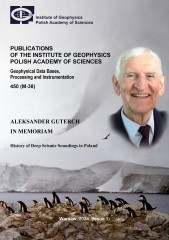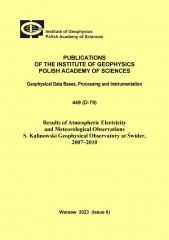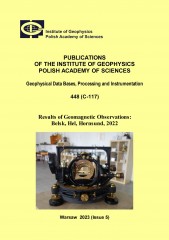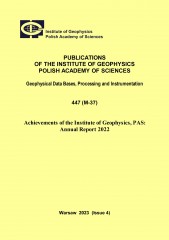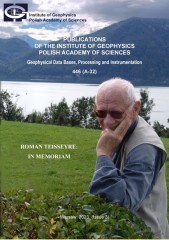BROWSE - VOLUME LIST
- A - Physics of the Earth's Interior
- B - Seismology
-
C - Geomagnetism
C-119, C-118, C-117, C-116, C-115, C-114, C-113, C-112, C-111, C-110, C-109, C-108, C-107, C-106, C-105, C-104, C-103, C-102, C-101, C-100, C-99, C-98, C-97, C-96, C-95, C-94, C-93, C-92, C-91, C-90, C-89, C-88, C-87, C-86, C-85, C-84, C-83, C-82, C-81, C-80, C-79, C-78, C-77, C-76, C-75, C-74, C-73, C-72, C-71, C-70, C-69, C-68, C-67, C-66, C-65, C-64, C-63, C-62, C-61, C-60, C-59, C-58, C-57, C-56, C-55, C-54, C-53, C-52, C-51, C-50, C-49, C-48, C-47, C-46, C-45, C-44, C-43, C-42, C-41, C-40, C-39, C-38, C-37, C-36, C-35, C-33, C-32, C-31, C-30, C-29, C-28, C-27, C-26, C-25, C-24, C-23, C-22, C-21, C-20, C-19, C-18, C-17, C-16, C-15, C-14, C-13, C-12, C-11, C-10, C-9, C-8, C-7, C-6, C-5, C-4, C-3, C-2, C-1
-
D - Physics of the Atmosphere
D-79, D-78, D-77, D-76, D-75, D-74, D-73, D-72, D-71, D-70, D-69, D-68, D-67, D-66, D-65, D-64, D-63, D-62, D-61, D-60, D-59, D-58, D-57, D-56, D-55, D-54, D-53, D-52, D-51, D-50, D-49, D-48, D-47, D-46, D-44, D-45, D-43, D-42, D-41, D-40, D-39, D-38, D-37, D-35, D-34, D-33, D-32, D-31, D-30, D-28, D-27, D-26, D-25, D-24, D-23, D-22, D-21, D-20, D-19, D-18, D-17, D-16, D-15, D-14, D-13, D-12, D-11, D-10, D-9, D-8, D-7, D-6, D-5, D-4, D-3, D-2, D-1
- E - Hydrology
- P - Polar Research
- M - Miscellanea
-
Online First
Browse - Volume list
Aleksander Guterch In Memoriam. History of Deep Seismic Soundings in Poland
Editor(s): Janik T., Czuba W., Dziembowska A.
Volume: 450
Series: M-38
DOI: 10.25171/InstGeoph_PAS_Publs-2024-001
Volume: 450
Series: M-38
DOI: 10.25171/InstGeoph_PAS_Publs-2024-001
This volume is an expression of respect for the outstanding Man of Science, Professor Aleksander Guterch, our long-time boss and colleague. We have tried to present his professional path and recall his greatest scientific achievements, presenting at the same time the history of the development of deep seismic soundings in Poland, which were inextricably linked to him.
Results of Atmospheric Electricity and Meteorological Observations, S. Kalinowski Geophysical Observatory at Świder, 2007–2010
Author(s): Kubicki M., Piłacik A.
Volume: 449
Series: D-79
DOI: 10.25171/InstGeoph_PAS_Publs-2023-026
Volume: 449
Series: D-79
DOI: 10.25171/InstGeoph_PAS_Publs-2023-026
Atmospheric electricity yearbooks have not been published since 2007. This was the result of the start of operation of the automatic database in which atmospheric electricity measurement data are recorded with high time resolution (1 or 10 seconds). In order to maintain the continuity of the form of the data presented in the Yearbooks of Atmospheric Electricity, a decision was made to resume publication. The presented publication contains a set of data for the years 2007–2010. The data contained in the yearbooks can be directly used for annual, seasonal, and daily analysis.
Results of Geomagnetic Observations: Belsk, Hel, Hornsund, 2022
Author(s): Reda J., Neska M., Wójcik S., Czubak P.
Volume: 448
Series: C-117
DOI: 10.25171/InstGeoph_PAS_Publs-2023-025
Volume: 448
Series: C-117
DOI: 10.25171/InstGeoph_PAS_Publs-2023-025
This publication contains basic information on geomagnetic observations carried out in 2022 in three Polish geophysical observatories: Belsk, Hel, and Hornsund. IAGA codes are respecti-vely: BEL, HLP, and HRN. All these observatories belong to the Institute of Geophysics, Polish Academy of Sciences. Observatories Belsk and Hel are located on the territory of Poland, while Hornsund is in Spitsbergen archipelago, under Norwegian administration.In 2022, like in the previous years, the Belsk, Hel, and Hornsund observatories have kept a close collaboration with the world network of geomagnetic observatories INTERMAGNET. The Belsk Observatory joined INTERMAGNET in 1992, Hel in 1999, and Hornsund in 2002. Data of geomagnetic field components XYZF have been sent to the INTERMAGNET centre in real time so they are publicly available on the Internet. At the beginning of 2023 have been prepared the final data (status Definitive) for the whole 2022 year observations. Definitive Data are publi
Achievements of the Institute of Geophysics, PAS: Annual Report 2022
Author(s):
Volume: 447
Series: M-37
DOI: 10.25171/InstGeoph_PAS_Publs-2023-023
Volume: 447
Series: M-37
DOI: 10.25171/InstGeoph_PAS_Publs-2023-023
This Monograph outlines the recent achievements of the Institute of Geophysics, Polish Academy of Sciences, focusing on the main strategic areas: Geosystem Processes, Earth Structure and Georesources, Anthropogenic and Natural Geohazards, Climate Change and Polar Research.
Roman Teisseyre: In Memoriam
Author(s):
Volume: 446
Series: A-32
DOI: 10.25171/InstGeoph_PAS_Publs-2023-003
Volume: 446
Series: A-32
DOI: 10.25171/InstGeoph_PAS_Publs-2023-003
Professor Roman Teisseyre, the outstanding modern geophysicist, was one of the most important and influential persons in the whole history of the Institute of Geophysics, Polish Academy of Sciences. His death ended the era of the founders and managers of the Institute who shaped, from its very beginning, the basic scientific profile of our place. Also, the friendly and pleasant atmosphere among the people working there, as initiated by him and the whole group of Institute’s founders, was prevalent over the years. He had many, many friends who quickly responded to our appeal to contribute to the present book In Memoriam.


